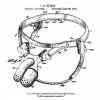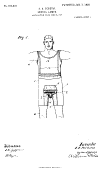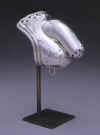The history of the chastity belt is difficult to prove. With little
documentary evidence available until the 15th Century any myths, legends and
stories before that time can only really be considered as conjecture.
Some of that conjecture includes:
Stories of Roman female slaves who were locked into chastity belts and
were only granted release for the sexual pleasure of their masters and
mistresses.
Tales of Roman prostitutes being forced to wear chastity belts which
exposed their vulvas, these were worn to tease potential male customers, the
belts only being removed once money had exchanged hands!
Legends and myths of Medieval Ladies being locked within chastity belts
until their Knights and Lords returned from fighting in the Crusades to free
them. Chaucer
does mention chastity in his writings, and medieval knights of the Crusades
did swear vows of obedience, loyalty, poverty and chastity. However, chastity
belts which claimed to have been manufactured around that time have since been
proven to be 19th Century "replicas", "curiosities" or
"fakes. In
1996, Felicity Riddy, a representative of Medieval Studies at York University
said "There is no medieval evidence, from Chaucer or anyone else. It all
points to an early urban myth brought back to life by the Victorians".
Two
of the best examples of so called Medieval chastity belts can be found in Musée
National du Moyen, the Cluny Museum of Paris. The photograph, left,
below is a belt originally thought to be made in the 12th Century, which has
since been proven to be a "curiosity". It has a metal
waist band covered in velvet and a crotch guard made of ivory which is
supposed to press firmly against the vagina. To the right of that is
another in the Cluny collection.


Chastity
Facts:
The
first documented reference to the term "chastity belt" is credited
to R'gine Pernoud, a Medieval historian who, in the 14th Century
explained that a simple cord worn around the waist was a symbol of chastity
(such as the robes of a monk or priest - the cord around his waist is a symbol
of his vows of chastity and purity).
The
first written evidence of a chastity belt was recorded by Keyser von Eichstad,
a retired solider who compiled a manuscript in 1405 about the art of war
and military equipment. In his book "Bellifortis" he included
a drawing of a chastity belt (picture below), with the inscription "Est
florentinarum hoc bracile dominarum ferreum et durum ab antea sit reseratum"
("breeches of hard Florentine iron that are closed at the front")
It is claimed that this chastity belt was worn by the women of Florence, Italy as a method of
preventing rape. The Bellifortis manuscript is held in the library
of Goettingen University, Germany.

Unlike
female chastity belts, the development of the male chastity belt or device has
been much easier to follow. It's history is much more recent and can be
traced through patients records. Below are 4 examples - the top 2 are
American and the lowest one is of a patent held at Leeds County Council,
Yorkshire. The middle called "The Timely Warning" is also an
American design of 1905 and is similar to the "Kali's Teeth
Bracelet" (an anti-erection device).




Between the 1850s
and the beginning of the Second World War male chastity devices were
developed for the purpose of preventing masturbation which the Victorian’s
believed was a cause of insanity. It is at this point where we can
see a distinct difference between male and female chastity belts/devices.
The Victorian view of the female chastity belt
was to protect the wearer from rape, and where therefore considered as a
method of security. However male chastity belts and devices were developed to
prevent "self abuse", “self pollution”, "nocturnal
emissions" and "insanity, imbecility and feeblemindedness"
which were considered to be the natural fate of any young man with lax moral
attitudes!

Above
is a chastity device Auctioned by Sotherby's in October 2001: The Catalogue
Description read "A rare French silver chastity device for a boy,
19th century shaped to closely fit the anatomy, struck with a French control
mark, on a bronze stand length 4in. (10.2cm.) Exhibited:
"Les Anti-Onania." Paris, Galerie Robert Montagut."
Sold for US$6,000
Today's
modern stainless steel chastity belt was developed by improving upon the
Florentine design by Hal Higginbottom in the late 1950s. Since 1958 Hal
produced male and female chastity belts from his workshop in Sheffield,
England, under the brand name of Tollyboy. His craftsmanship was of
excellent quality and his belts were considered to be the "Rolls
Royce" of chastity belts. It is Hal Higginbottom who was credited
with bringing the chastity belt into the 20th Century.
However,
due to demand and the increased interest in chastity, Hal had a long waiting
list and his speed of production seemed slow to the eager, impatient buyer.
With the demand for chastity belts increasing others were encouraged to
manufacturer belts. The Tollyboy design was adapted in the USA by Jones
and Access Denied (01/07/1997), and in Germany by Neosteel.
Hal
Higginbottom became very ill with respiratory problems, and passed away on
21/05/98. Today the Tollyboy name lives on with Richard Davies
(apprentice to Hal) continuing to produce the "Florentine" design,
made to measure, steel chastity belts for men and women.

Since
the late 1990s the availability of male chastity devices is much higher.
Major Players have been Frank & Doris Miller who launched the CB-2000 in
1998. It was the world's first easily available polycarbonate male chastity
device. The Millers have since added the
Curve, the CB-3000 and the CB-6000 to their range of plastic devices.
As
you will see from viewing our gallery pages there is now a wide choice of male
chastity devices, with noticeable differences in design. However, in
comparison little advancement has been made to the female belt, the basic
design remain the same.
Male
chastity devices are now readily available from many specialist online shops.
We recommend that when purchasing you look for those shops and web sites,
which know something about chastity, and will be able to help you with any
problems you may initially have.
Tickleberry
- UK/Europe














